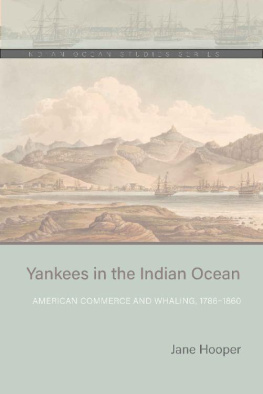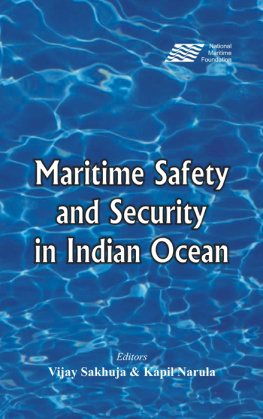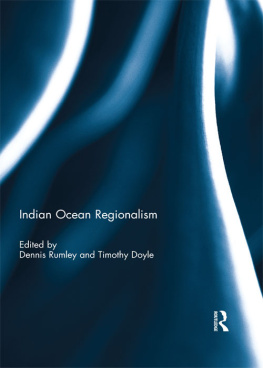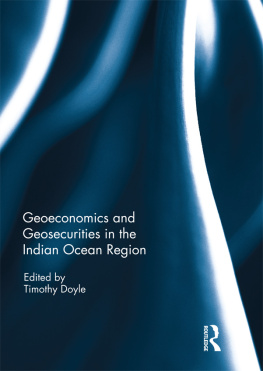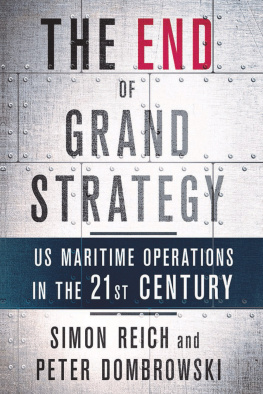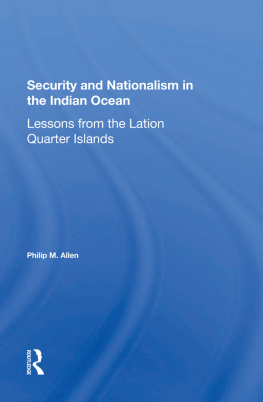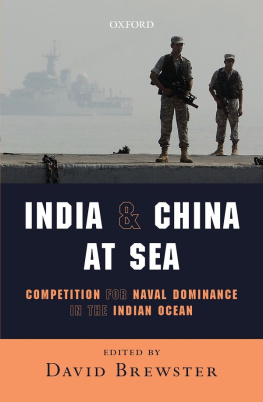THE INDIAN OCEAN AND US GRAND STRATEGY
SOUTH ASIA IN WORLD AFFAIRS SERIES
T. V. Paul, Series Editor
Editorial Advisory Board
Rajesh Basrur
Maya Chadda
Stephen P. Cohen
C. Christine Fair
Timothy Hoyt
Paul Kapur
Rajesh Rajagopalan
Aseema Sinha
Titles in the Series
Afghan Endgames: Strategy and Policy Choices for Americas Longest War
HY ROTHSTEIN AND JOHN ARQUILLA, EDITORS
The Engagement Of India: Strategies and Responses
IAN HALL, EDITOR
Globalization and Indias Economic Integration
BALDEV RAJ NAYAR
The Indian Ocean and US Grand Strategy: Ensuring Access and Promoting Security
PETER DOMBROWSKI AND ANDREW C. WINNER, EDITORS
Indias Rise as an Asian Power: Nation, Neighborhood, and Region
SANDY GORDON
Pakistans Counterterrorism Challenge
MOEED YUSUF, EDITOR
Vying for Allahs Vote: Understanding Islamic Parties, Political Violence, and Extremism in Pakistan
HAROON K. ULLAH
THE INDIAN OCEAN AND US GRAND STRATEGY
Ensuring Access and Promoting Security
PETER DOMBROWSKI AND ANDREW C. WINNER, EDITORS
2014 Georgetown University Press. All rights reserved. No part of this book may be reproduced or utilized in any form or by any means, electronic or mechanical, including photocopying and recording, or by any information storage and retrieval system, without permission in writing from the publisher.
Library of Congress Cataloging-in-Publication Data
The Indian Ocean and US grand strategy: ensuring access and promoting security / Andrew C. Winner and Peter Dombrowski, editors.
pages cm(South Asia in world affairs series)
Includes bibliographical references and index.
ISBN 978-1-62616-140-5 (hardcover: alk. paper)ISBN 978-1-62616-079-8 (pbk.: alk. paper)
ISBN 978-1-62616-150-4 (ebook)
1. Indian Ocean RegionForeign relationsUnited States. 2. United StatesForeign relationsIndian Ocean Region. 3. Indian Ocean RegionStrategic aspects. I. Winner, Andrew C., editor of compilation. II. Dombrowski, Peter J., 1963editor of compilation. III. Winner, Andrew C. American strategy in the Indian Ocean. Contains (work): IV. Series: South Asia in world affairs series.
DS341.3.U6I53 2014
355.033573091824dc23
2014011312
This book is printed on acid-free paper meeting the requirements of the American National Standard for Permanence in Paper for Printed Library Materials.
15 14 13 9 8 7 6 5 4 3 2 First printing
Printed in the United States of America
Cover design by Auburn Associates, Inc. Cover photo courtesy of U.S. Navy / Mass
Communication Specialist Seaman George M. Bell.
CONTENTS
ANDREW C. WINNER AND PETER DOMBROWSKI
WALTER C. LADWIG III
WILLIAM C. MARTEL
CHRISTOPHER A. PREBLE
JAMES R. HOLMES AND TOSHI YOSHIHARA
RODGER A. PAYNE
MICHAEL AUSLIN
TERESITA C. SCHAFFER
ANDREW C. WINNER
PETER DOMBROWSKI AND ANDREW C. WINNER
ACKNOWLEDGMENTS
As is usual for a project like this one, the authors have incurred many debts. Scholars, policymakers, and officers both inside and outside the US government encouraged us and took the time to explain the nuances of policies and programs. First and foremost we would like to thank Lieutenant General (Retired) Chip Gregson, Kathleen Hicks, and Ambassador Sandy Vershbow, for asking the Naval War College to support an internal US government review of American strategy and policy in the Indian Ocean region. Their deputies and assistantsincluding, among others, Shawn Brimley, Janine Davidson, Amanda Dory, Lindsay Ford, and Robert Scherall gave generously of their time and expertise. Our Naval War College colleagues Peter Dutton, Timothy Hoyt, and Gary McKenna worked long and hard. Finally, last but not least, we would like to thank Robert Art of Brandeis University for joining us for an early workshop as we considered turning policy-oriented research into scholarly chapters worthy of being read by a wider audience. Bobs insights into strategy proved invaluable in delineating the concepts underlying this entire volume. Three anonymous referees forced us to write more clearly. Don Jacobs, our acquisitions editor at Georgetown University Press, and T. V. Paul, the series editor, provided encouragement and valuable feedback. Naturally, we fully assume responsibility for all errors that remain.
CHAPTER 1
INTRODUCTION
American Strategy in the Indian Ocean
ANDREW C. WINNER AND PETER DOMBROWSKI
The Indian Ocean is the third-largest ocean in the world. Its littoral consists of forty-seven countries, and several strategically important islands are contained within its boundaries. Access to the Indian Ocean is controlled by nine passages, of which five are key sea lines of communication (SLOCs) used to transport energy. This increasing dependence of China on the importing of oil and other hydrocarbons is a central factor in the large and growing percentage of the worlds energy, raw materials, and general merchandise trade flows that cross the Indian Ocean. In sum, the Indian Ocean has replaced the North Atlantic as the central artery of global commerce. Therefore, external security threats or internal disruptions in the Indian Ocean region could have serious implications for many countries and the global economy as a whole.
The Indian Ocean is also becoming, once again, a distinct and increasingly important geographic space as well as a potentially contentious political arena.growth and commercial reach. For the first time in the modern era Chinese naval vessels are patrolling the western reaches of the Indian Ocean. Chinese corporations, including some with close ties to the Beijing government and all with diplomatic support, are investing deep inside Africa, not to mention ports and other infrastructure in Pakistan, Sri Lanka, and beyond. India has watched each Chinese move with suspicion while remaining cautious of American overtures toward establishing greater bilateral political and military cooperation. Meanwhile, third parties from the Indian Ocean and beyondfrom Australia to Japan to several European statescontinue to maintain a presence in the region or are in the process of expanding previously limited roles.
The United States therefore needs to strongly consider whether to develop a strategy for how it is going to pursue and protect its interests in this distant maritime region. The rise of the Indian Ocean as an artery of global commerce and its potential as a venue for geopolitical conflict raise questions about whether, and how, American policymakers should adjust their previously limited approach to the region. The premise of this book is that a US strategy for the Indian Ocean is necessary, and the authors of the volumes chapters outline various potential strategic approaches. Before the United States decides whether to develop a distinctive regional strategy for the Indian Ocean, key questions must be answered:
What exactly are the US interests in the Indian Ocean region?
What are the key geopolitical characteristics of the region, and how are they evolving?
How can the United States increase its leverage to protect and advance its national interests in the region?



